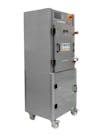By Bruce Geiselman
Carbon in early 2022 will launch the latest generation of Carbon Design Engine software and, for the first time, it will be available for license by anyone, not just users of the company’s 3D printers.
Carbon Design Engine software, introduced in February 2021, allows designers to generate parts with advanced lattices quickly and easily from a solid part STL file and output STL files for printing on most common 3D printers. Previously, the software was only available to Carbon customers. Carbon hopes to help accelerate the product development process for more users of both polymer and metal printers.
This is a significant change for Carbon, which has helped companies like Adidas, Riddell, Rawlings, Specialized and CCM develop lattice structures that provide lightweight cushioning and stability in products such as athletic shoes, football and hockey helmets, baseball gloves and bicycle seats.
“Essentially, we’re providing an idea-to-production platform that is a single solution for creators to collaborate with each other to develop better products and bring them to market faster,” Phillip DeSimone, Carbon’s chief product and business development officer, told Plastics Machinery & Manufacturing. “All of the power of what you got from engaging with our application engineering team, all those tools that we’ve been using in the background to make products for CCM, Riddell and Specialized come to life, customers will now have the ability to do that on their own.”
The purpose is to bring new products to market as quickly as possible, DeSimone said.
“I think we have taken a leadership position in getting companies to bring products to market using additive [manufacturing] at scale more so than anyone else.”
Printing technology and materials have advanced significantly in the past five to 10 years, but manufacturers have been looking for software to help them design products optimized for 3D production, he said.
“We believe the majority of the challenge for adoption is around education and platform tools to take advantage of the technologies,” DeSimone said. “Now, we have built these platform tools from the ground up because we’ve had to in order to get some of the largest consumer product applications with 3D printers in the world to scale.”
Carbon decided to open its software up for use on a variety of 3D printers because a full solution can be “technology agnostic,” DeSimone said.
“We will be licensing this product as a separate product line from our printers,” he said. “It is its own software design package and will be purchased similarly to if you were buying any other CAD-based design product … This will be the first foray for Carbon in expanding its ecosystem.”
Design Engine allows users to design products in less time. It automates complex product design and development tasks, from prototyping to production. Innovative products created with Design Engine have successfully moved from design to production in months and then been produced at scale, according to the company.
“Creators are challenged with fragmented solutions and organizational silos that have caused friction, limitations on innovation, and delayed time to market,” DeSimone said in a press release. “To successfully bring better products to market in less time, organizations need a platform that unifies product design, development and manufacturing.”
Lattice structures require less material, while offering excellent performance, the company said. Latticed parts provide advantages, including light weight, flexibility, improved cushioning and dampening, heat dissipation and unique aesthetics.
The software runs complex computations quickly on cloud-based servers, allowing users to refine lattice designs in minutes, the company said. Most 3D printers can then manufacture the designs immediately. As a result, creators can go from an idea to a functional lattice part in hours, rather than days.
Carbon will offer Design Engine in three tiers: Standard, Pro and Enterprise. Customers can purchase individual or team licenses.
The Pro tier includes additional features such as the ability to tune multiple zones at once, integrating different lattice types, cell sizes or strut diameters to create different zones of performance within a single part using the same material. The Pro tier also allows designers to seamlessly blend zones, producing attractive, functional lattices, the company said.
Bruce Geiselman, senior staff reporter
Contact:
Carbon Inc., Redwood City, Calif., 650-285-6307, www.carbon3d.com






